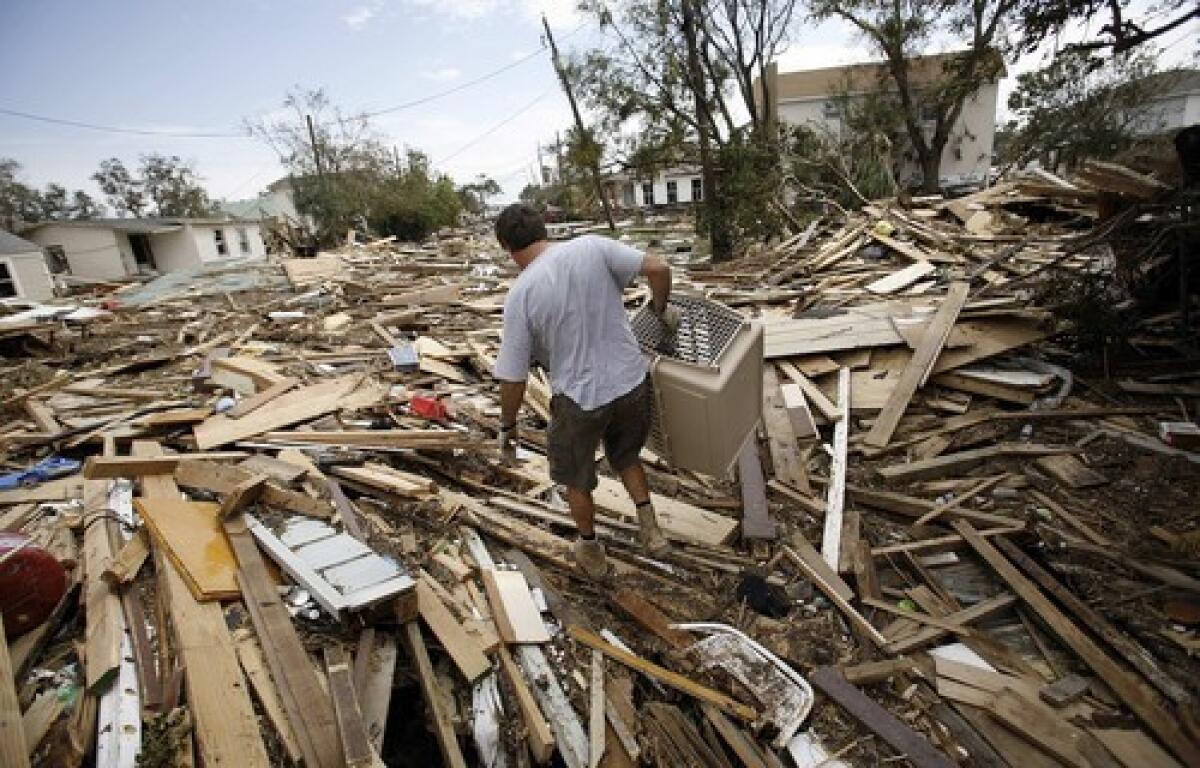Texans warned to stay away from areas hit by Hurricane Ike

- Share via
GALVESTON, TEXAS — The road leading onto this barrier island was a jumble of crushed homes, splintered boat docks and mounds of sand. City officials who had ordered residents to leave ahead of Hurricane Ike were telling them Monday to stay away -- maybe for weeks.
But for Vernon Baines, pastor of the tiny Live Oak Baptist Church, the need to come back was too strong. So he, like hundreds of others who had fled this slice of land along the Gulf Coast, sneaked back -- hungry for a glimpse of the familiar and hopeful that their homes had escaped the storm’s wrath.
They discovered much of the town had been turned into a garbage dump.
At Baines’ church, a foot of dank water covered the sanctuary floors, the roof was peeled back and muck covered the pews in thick, black streaks.
“There’s nothing untouched -- nothing at all,” said Baines, 53, his eyes tearing. “Inside, outside, everywhere. There’s no place that’s untouched.”
Officials were in the early stages Monday of assessing the effects of the storm, which battered Galveston over the weekend with 110-mph winds and a 15-foot storm surge before roaring north to Houston. There was no electricity on the island. No running water, functioning sewage system or telephone service. Galveston’s west side -- neighborhoods and resorts that extend beyond the protection of the city’s 17-foot sea wall -- was inaccessible to all but rescue crews.
“It’s going to take weeks and months to get this place cleaned up,” City Manager Steve LeBlanc said.
With thousands of people failing to heed mandatory evacuation orders ahead of the storm and mosquitoes seemingly everywhere, LeBlanc said, “Quite frankly, we are reaching a health crisis.”
Four people were confirmed dead in Galveston, bringing Ike’s death toll to at least 40 as flooding caused by remnants of the storm stretched from the Gulf Coast through the Ohio Valley.
LeBlanc estimated that as many as 20,000 of Galveston’s 57,000 residents were still in their homes. About 2,000 accepted an offer Sunday to take buses to shelters in San Antonio and Austin. An additional 3,000 asked to be evacuated Monday.
Fallen trees blocked the island’s streets, and rows of once-elegant beach homes had been reduced to story-high piles of twisted steel and sodden clothing. Elsewhere on the island, houses that appeared unscathed from a distance were waterlogged inside.
Depending on which way the wind was blowing, the air reeked of saltwater, fuel, sewage -- or a combination of all three.
Sailboats and fishing trawlers lay in heaps in the parking lots of Galveston’s historical Strand District. A crew of 22 Coast Guard personnel who rode out the hurricane aboard the cutter Harry Claiborne returned to the island Monday to find their vehicles tossed along the side of a road -- bashed pickups and SUVs twisted around chunks of concrete and lumber.
“One guy has a shrimp boat in his front yard,” said Chief Petty Officer Chris Boss.
Debris clogged the island’s waterways as well: Coast Guard officials said that 90% of the navigational aids used to guide ships through the channel had been destroyed or damaged, and the water was littered with car upholstery, toilet seats and cow carcasses.
Galveston Mayor Lyda Ann Thomas ordered a mandatory evacuation Monday of all nonessential personnel from the island. “There is nothing to come here for right now,” Thomas said at a news conference. “Please leave.”
Similar sentiments were repeated across southeast Texas. In hard-hit towns like Orange and Bridge City, authorities continued to search for people trapped in their homes without supplies or power.
In Houston, local and federal emergency authorities opened distribution centers for residents in need of food, water and ice. Mayor Bill White advised residents that they needed to boil any water coming from the city’s supply before using it. The downtown streets largely had been cleaned of the broken glass and debris, but officials said that more than 1.6 million customers remained without power. Some shops and restaurants were open but hours were limited because of a curfew.
In Galveston, the talk was less about when the power would return than about when people could come home.
John Koloen, who works in public affairs at the University of Texas Medical Branch in Galveston, rode out the storm at the hospital. His mother in Wisconsin is ill, he said, and he had planned to fly there this week.
“If I leave, when will I be able to come home?” wondered Koloen, 60, whose home flooded in the storm. “There’s no resources. There’s no people. There’s only uncertainty and feeling helpless.”
More to Read
Sign up for Essential California
The most important California stories and recommendations in your inbox every morning.
You may occasionally receive promotional content from the Los Angeles Times.











